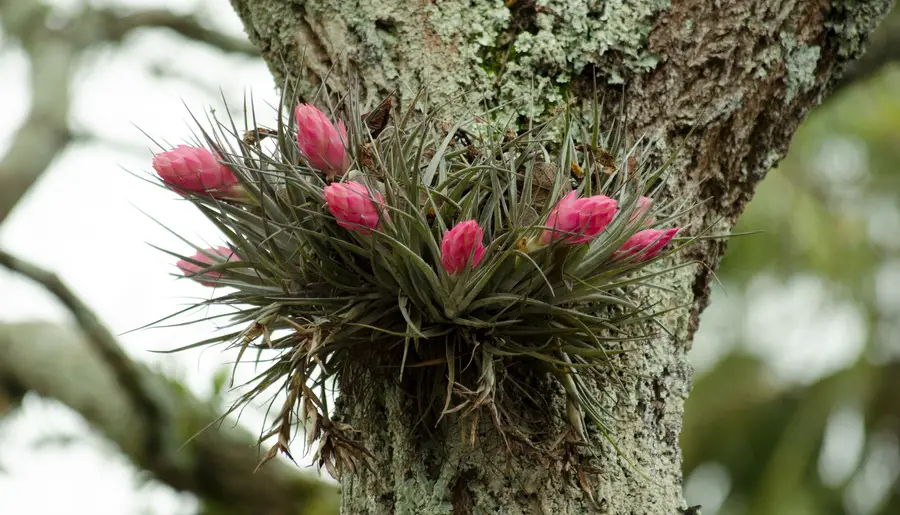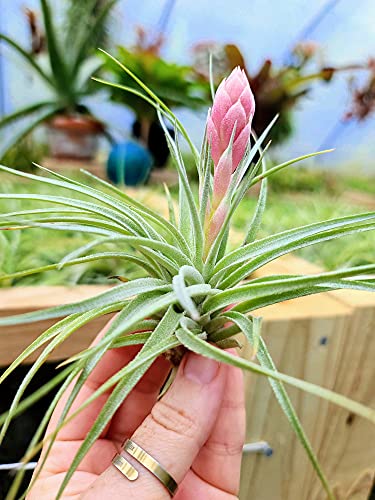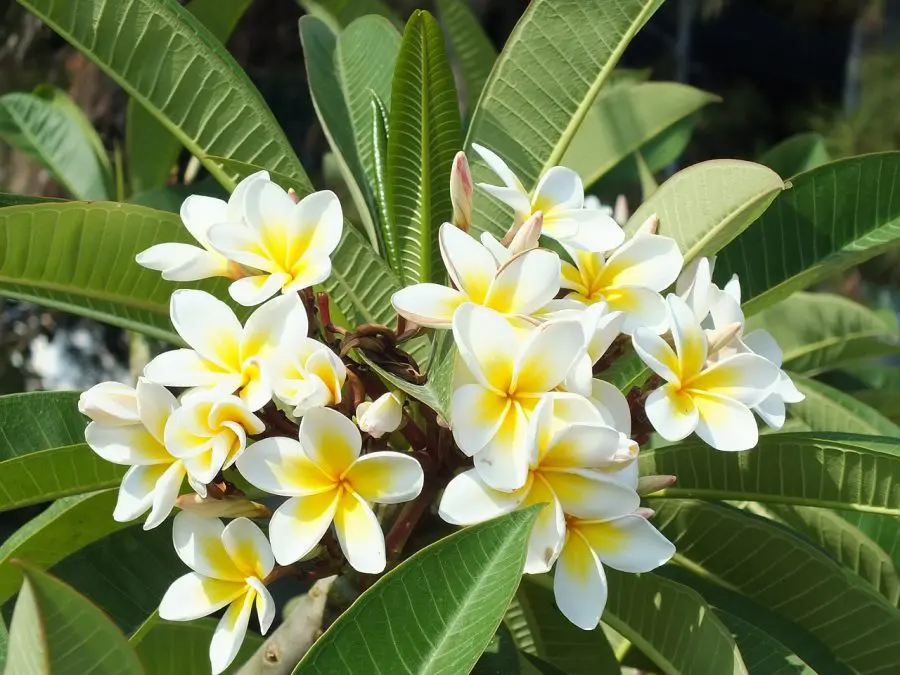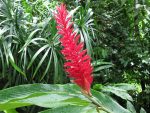This post contains affiliate links. If you buy something from one of our links we may earn a commission. Thanks

Discover the secrets of happy, thriving air plants as we reveal just how long to soak air plants, plus tips and tricks for how to water air plants in any season
How long to soak air plants depends on their specific needs and the environment they’re in. Generally, soaking them in room-temperature water for 20-30 minutes once a week is sufficient. Make sure to shake off excess water and allow them to dry fully before placing them back in their display to avoid root rot.
Are you ready to dive into the wonderful world of air plants?
These unique, low-maintenance beauties are a popular choice for plant enthusiasts, but it can be a bit tricky to figure out the best way to water and care for them.
Are you wondering how long to soak air plants and how to give them the best care possible? You’ve come to the right place!
In this easy-to-follow guide, we’ll dive into the fascinating world of air plants, uncovering the secret to their proper watering and sharing useful tips that will help your little green friends flourish.
So, let’s jump right in and start making your home a true air plant haven!
Introduction To How Long to Soak Air Plants
Welcome to our guide on air plant care, where we’ll explore everything you need to know to keep your little green buddies thriving!
In this introduction, we’ll touch on topics like watering routines, light requirements, and even the best ways to display your air plants.
So, whether you’re a seasoned enthusiast or just starting your journey with these captivating plants, you’re sure to find something valuable in this post.
Let’s dive in and discover the secrets to creating a happy and healthy air plant environment!
A Closer Look at Air Plants
Air plants, also known as Tillandsia, are unique and captivating members of the plant world. They are members of the Bromeliad family and most are native to South America.
They are epiphytes, meaning they grow without the need for soil, instead absorbing nutrients and moisture directly from the air.
Their intriguing shapes, low-maintenance nature, and ability to thrive in a variety of environments make them a popular choice for plant enthusiasts and beginners alike.
Mesic air plants grow in a humid climate but some xeric air plants grow in drier arid climates. In this section, we’ll delve deeper into what makes these fascinating plants so special.
All air plants prefer bright indirect light and should not be placed in strong direct sunlight.
The Key Role of Watering Techniques
Water is essential for keeping your air plants healthy, and understanding the proper techniques for hydration is crucial.
Since air plants don’t rely on soil to obtain moisture, their watering needs differ from most other plants.
By mastering the art of watering your Tillandsia, you’ll be setting the stage for them to grow and flourish in your care.
In this part of our guide, we’ll discuss the importance of proper watering methods, covering topics like frequency, duration, and signs of over- or under-watering.
Together, we’ll ensure your air plants stay vibrant and happy.
How to water air plants
Ready to learn the ins and outs of watering your air plants?
In this section, we’ll guide you through the process step by step, ensuring that your Tillandsia friends receive the hydration they need to thrive.
From soaking to misting, we’ll cover different methods and tips that cater to your plant’s unique requirements.
So, whether you’re brand new to air plant care or just looking to refine your skills, let’s dive into the world of air plant hydration together and keep your green companions happy and healthy!
Exploring Watering Methods for Air Plants
The Soaking Method
One popular method for watering air plants is the soaking method. It involves submerging your air plants in a container filled with water for a specific amount of time.
Always use room temperature water as cold water can shock your plants.
This allows the plants to absorb the moisture they need, giving them a thorough and efficient hydration session.
In this section, we’ll discuss the best practices for soaking, including water temperature, soaking duration, and how to dry your air plants afterward.
The Misting Method
Misting is another great way to keep your air plants hydrated, especially for those living in more humid environments.
By misting your plants with water, you create a microclimate that mimics their natural habitat.
We’ll go over the proper techniques for misting, how often to mist, and the benefits of incorporating this method into your air plant care routine.
Picking the Perfect Watering Method for Your Air Plant
With multiple watering methods to choose from, it’s essential to select the one that best suits your air plant’s specific needs.
Factors such as humidity, temperature, and air circulation can all impact your plant’s hydration requirements.
In this part of our guide, we’ll help you determine the right watering method for your unique air plant, taking into consideration its individual characteristics and your home environment.
Together, we’ll ensure your air plant stays happy, healthy, and well-hydrated.
How Long To Soak Air Plants
Are you eager to learn the optimal soaking duration for your air plants? In this section, we’ll unravel the mystery of how long to soak air plants and provide you with the essential information to keep your Tillandsia hydrated and content.
We’ll discuss factors that influence soaking time and help you tailor the perfect watering routine for your air plant’s specific needs.
So, let’s dive in and ensure your charming green friends enjoy the perfect soak every time!
General Guidelines for Soaking Air Plants
Before diving into specific factors that affect soaking duration, it’s important to establish some general guidelines.
These will serve as a starting point for determining the ideal soaking time for your air plants.
In this section, we’ll provide you with a basic understanding of how long to soak air plants, and how to adapt these guidelines based on your unique circumstances.
Factors Affecting Soaking Duration
Plant Size
The size of your air plant plays a role in determining how long it should be soaked.
Smaller plants typically require less soaking time, while larger plants need more time to fully hydrate.
In this part of our guide, we’ll explore how to adjust soaking times based on your air plant’s size, ensuring they receive the proper amount of moisture.
Humidity Levels
Humidity levels in your environment can greatly impact the soaking duration for your air plants.
In areas with higher humidity, plants may require shorter soaks, while drier environments might call for longer sessions.
We’ll discuss how to take humidity into account when determining the best soaking duration for your air plants.
Temperature
Temperature is another important factor to consider when soaking your air plants.
Warmer temperatures can cause water to evaporate more quickly, potentially requiring longer soaks to keep your plants well-hydrated.
In this section, we’ll delve into the relationship between temperature and soaking time, helping you adapt your watering routine to ensure your air plants remain healthy and happy.
How often to water air plants in winter
As winter approaches and temperatures drop, you might be wondering how to adjust your air plant care routine to keep your green companions happy.
In this section, we’ll focus on the question of how often to water air plants in winter and provide you with the guidance you need to navigate this cooler season.
We’ll cover essential tips for maintaining proper hydration, taking into account the unique challenges that winter brings.
So, grab a cozy blanket, and let’s explore how to keep your air plants thriving even when it’s chilly outside!
Adapting Your Watering Schedule for Seasonal Changes
As the seasons change, so do the needs of your air plants.
It’s essential to adapt your watering schedule accordingly to maintain optimal hydration levels.
In this section, we’ll discuss how to adjust your watering frequency during the winter months, taking into consideration factors such as temperature, humidity, and available indirect sunlight.
By following these guidelines, you’ll ensure your air plants remain healthy and vibrant all year long.
Essential Tips for Winter Air Plant Care
In addition to adjusting your watering schedule, there are other important aspects of winter air plant care to keep in mind.
To help your plants thrive during the colder months, we’ll share some valuable tips on maintaining proper humidity, temperature, and light levels in your home.
We’ll also cover potential challenges that winter presents, such as drafts and reduced sunlight, and provide you with solutions to overcome these obstacles.
By following our winter care tips, you’ll create a cozy and nurturing environment for your air plants even when the weather outside is frightful.
Do you soak air plants upside down?
If you’ve ever wondered, do you soak air plants upside down? Well, you’re not alone!
This question often puzzles air plant enthusiasts, both new and experienced. In this section, we’ll dive into the proper orientation for soaking air plants and discuss the reasons behind it.
We’ll also provide helpful tips to ensure your plants stay healthy during their hydration sessions.
So, let’s explore this curious aspect of air plant care together and keep your green buddies flourishing and happy!
Understanding the Purpose of Soaking Upside Down
You might be wondering why some air plant owners choose to soak their air plant upside down.
This unconventional technique actually is a good idea that serves a specific purpose.
In this section, we’ll discuss the benefits of soaking air plants upside down, including how it helps prevent rot, encourages proper drying, and mimics their natural habitat.
By understanding the reasoning behind this method, you’ll be well-equipped to decide if it’s the right approach for your air plants.
Determining When to Use the Upside-Down Soaking Technique
Now that you know the purpose of soaking air plants upside down, it’s important to understand when to use this technique.
Different air plants have different needs, and what works well for one might not be suitable for another.
In this part of our guide, we’ll explore factors to consider when deciding whether to adopt the upside-down soaking method, such as your plant’s species, size, and specific requirements.
With this knowledge, you’ll be able to make an informed decision on the best soaking method for your unique air plant.
How to dry air plants after soaking
You’ve learned the ins and outs of soaking your air plants, but what about the drying process?
In this section, we’ll discuss the essential steps for drying air plants after soaking, ensuring they stay healthy and free from potential issues like rot.
We’ll share tips and tricks for proper drying techniques, as well as ways to prevent common problems that can arise during the process.
So, let’s dive in and learn how to keep your air plants happy and thriving after their rejuvenating soak!
Mastering Proper Drying Techniques
After soaking your air plants, it’s crucial to ensure they dry properly to maintain their health.
In this section, we’ll cover the best techniques for drying air plants, such as positioning, air circulation, and drying duration.
We’ll also provide guidance on how to handle delicate or larger plants, ensuring they receive the care they need.
By mastering these techniques, you’ll help your air plants transition smoothly from soaking to drying, setting them up for success in your care.
How to dry air plants after soaking
Now that we’ve covered the soaking aspect of air plant care, it’s time to explore the equally important process of drying them afterward.
Proper drying is crucial in preventing rot and maintaining the overall health of your air plants.
In this guide, we’ll share some essential tips and tricks to ensure your leafy friends are dried just right after their refreshing soak.
So, let’s get ready to dive into the art of air plant drying and keep those lovely green companions in prime condition!
Proper Drying Techniques
After soaking your air plants, it’s essential to dry them thoroughly to ensure their health and happiness. Follow these simple steps for proper drying:
Shake It Off: Gently shake your air plants to remove excess water from their leaves and crevices. This helps prevent water from getting trapped and causing rot.
Upside-Down Draining: Hang or place your air plants and dry them upside down, allowing gravity to assist in draining any remaining water from the plant’s base.
Airy Abode: Place your air plants in a well-ventilated area with good air circulation to promote quick and even drying. Avoid putting them back in their usual display spot until they are completely dry.
Patience is Key: Allow your air plants to dry for a few hours or even overnight, depending on the size and thickness of the leaves. Remember, patience is essential in ensuring your plants are dried thoroughly!
Keeping It Fresh: Preventing Mold and Rot
Ensuring your air plants are properly dried after soaking is crucial in preventing mold and rot from developing.
Here are some additional tips to help you avoid these issues:
Monitor Humidity: Be mindful of the humidity levels in your home, as high humidity can prolong the drying process and increase the risk of mold and rot. Use a dehumidifier if necessary to maintain a healthy environment for your air plants.
Weekly Check-Up: Regularly inspect your air plants for any signs of mold or rot, such as blackened or mushy areas. Catching these issues early can prevent the spread of damage and save your plants.
Learn from Experience: If you’ve experienced mold or rot issues with your air plants in the past, take note of the factors that may have contributed to the problem and adjust your care practices accordingly.
By following these drying tips and keeping an eye out for signs of trouble, you’ll be well on your way to maintaining happy, healthy air plants!
Keeping Mold and Rot at Bay
One of the key reasons to focus on proper drying techniques is to prevent the growth of mold and rot, caused by too much water remaining which can be detrimental to your air plants.
In this part of our guide, we’ll delve into the importance of thorough drying, as well as provide tips for recognizing early signs of mold and rot.
We’ll also discuss preventative measures you can take to create a healthy environment for your air plants, ensuring they stay vibrant and problem-free.
By following these guidelines, you’ll be well on your way to nurturing a thriving air plant collection.
Xeric air plants vs mesic air plants watering
Air plants, also known as Tillandsia, are fascinating and versatile plants that have evolved to adapt to various environments.
Xeric types and mesic types of air plants are two broad categories of air plants that thrive in different types of habitats, and as such, they have different watering requirements.
Xeric Air Plants:
Xeric air plants are native to dry, arid environments and are adapted to withstand prolonged periods of drought.
They have thicker leaves covered with more trichomes, which help them absorb and retain water.
Examples of xeric air plants include Tillandsia xerographica and Tillandsia tectorum.
Another xeric tillandsia is Spanish moss (Tillandsia usneoides) an epiphytic flowering plant that often grows in the Southern United States upon large trees in tropical and subtropical climates.
Watering Xeric Air Plants:
Misting: Mist xeric air plants 1-2 times a week, ensuring that you wet the entire plant.
Soaking: Soak xeric air plants for 20-30 minutes every 2-3 weeks in a bowl of water.
However, some xeric species might not require soaking as frequently or for as long, so be sure to research the specific needs of your plant.
Frequent misting also may not be required as these plants are naturally used to less water.
Mesic Air Plants:
Mesic air plants are native to environments with higher humidity and more consistent rainfall, such as rainforests.
They generally have thinner leaves with fewer trichomes compared to xeric air plants.
Examples of mesic air plants include Tillandsia bulbosa and Tillandsia ionantha.
Watering Mesic Air Plants:
Misting: Because they come from a humid environment mist mesic air plants 2-3 times a week to maintain their moisture levels.
Soaking: Soak mesic air plants for 20-30 minutes once a week, allowing them to absorb enough water to last until their next soak.
It’s crucial to adjust your watering routine depending on the type of air plant you’re caring for, as well as the environmental conditions in your home.
Always monitor your air plants’ health and appearance, and be prepared to adapt your care routine to meet their specific needs.
Which air plants should not be soaked?
As you continue your air plant care journey, you may discover that not all air plants should be soaked.
In this section, we’ll explore the types of air plants that prefer alternative watering methods, as well as the reasons behind their unique preferences.
By understanding these distinctions, you’ll be better equipped to provide tailored care for each plant in your collection.
So, let’s dive in and learn how to identify and nurture air plants that don’t appreciate a good soak!
Spotting Sensitive Air Plant Species
While many air plants thrive with a good soak, certain species are more sensitive to this watering method.
In this section, we’ll help you identify these particular air plants by discussing their unique characteristics and growth habits.
By learning to recognize sensitive species, you’ll be able to provide the appropriate care and avoid potential problems associated with over-soaking.
Embracing Alternative Watering Methods for Sensitive Plants
For air plants that don’t appreciate soaking, it’s important to explore alternative watering methods to keep them hydrated and healthy.
In this part of our guide, we’ll discuss suitable alternatives, such as misting, spraying, or even using a damp cloth to provide moisture.
We’ll also cover how to adjust the frequency and duration of these methods to cater to the needs of sensitive air plant species.
By following these tailored approaches, you’ll ensure that even the most delicate air plants in your collection receive the care they need to flourish.
Delicate Dwellers: Identifying Sensitive Species
While many air plant varieties can tolerate and even thrive with regular soaking, some species are more sensitive to this watering method.
These delicate air plants may be more susceptible to rot or other issues when soaked. Some examples of sensitive air plant species include:
Tillandsia xerographica: Known for its stunning silvery leaves, this air plant prefers a drier environment and is more susceptible to rot if soaked too frequently.
Tillandsia tectorum: This fuzzy air plant has trichomes that help it absorb moisture from the air. Soaking can cause the trichomes to become waterlogged, leading to potential health issues.
Tillandsia funckiana: With its thin, curly leaves, this air plant is more prone to drying out quickly and may not benefit as much from soaking.
It’s essential to research and understand the specific needs of your air plant varieties to provide the best care possible.
Alternative Watering Methods for These Plants
For air plants that prefer not to be soaked, there are other methods to keep them hydrated and healthy:
Misting: A light misting 2-3 times a week can provide sufficient moisture for sensitive air plant species. Be sure to mist in the morning, allowing the plants to dry before nighttime.
Light Soaking: While some sensitive species may not appreciate frequent full soaks, a quick 5-10 minute soak every couple of weeks can help maintain their hydration without causing harm.
Environmental Humidity: Providing a humid environment by grouping plants together or using a humidifier can help keep sensitive air plants happy and healthy.
Remember, the key to successful air plant care is understanding your specific plant’s needs and adjusting your watering methods accordingly.
How Often To Mist Air Plants
If you’re considering misting as a method to keep your air plants hydrated, you might be wondering just how often to mist them.
In this section, we’ll delve into the art of misting air plants, providing guidance on the ideal frequency to keep your green friends happy and well-nourished.
We’ll also discuss factors that can influence your misting schedule, such as humidity levels, temperature, and plant type.
So, grab your spray bottle, and let’s explore the world of misting air plants together!
Determining Misting Frequency
To ensure your air plants receive the proper hydration through misting, it’s essential to establish an appropriate misting frequency.
In this section, we’ll discuss general guidelines for how often to mist your air plants, taking into consideration factors such as environmental conditions and plant type.
By understanding the right misting frequency for your unique situation, you’ll be well on your way to keeping your air plants happy and thriving.
Mastering Tips for Effective Misting
Misting can be a fantastic way to hydrate your air plants, but there’s more to it than simply spraying water.
In this part of our guide, we’ll provide tips and tricks for effective misting, such as using the right type of water, misting at the best time of day, and ensuring proper air circulation.
By following these suggestions, you’ll maximize the benefits of misting and create an ideal environment for your air plants to flourish.
Distilled water for air plants
When it comes to watering your air plants, you might be curious about the best type of water to use.
In this section, we’ll explore the benefits of using distilled water for air plants and discuss the reasons behind this recommendation.
We’ll also touch on other water sources and their potential effects on your green companions.
So, let’s dive in and learn how choosing the right water can make all the difference in keeping your air plants healthy and vibrant!
Reaping the Benefits of Distilled Water
Choosing the right water for your air plants can have a significant impact on their health and well-being.
In this section, we’ll discuss the benefits of using distilled water for air plants, including its purity, absence of harmful chemicals, and suitability for sensitive species.
By understanding the advantages of distilled water, you’ll be well-equipped to make informed decisions about your air plant watering routine.
Exploring Other Suitable Water Sources
While distilled water is often recommended for air plants, there are other water sources that can also be suitable.
In this part of our guide, we’ll examine alternative options, such as rainwater, filtered water, and dechlorinated tap water.
We’ll discuss the pros and cons of each and provide guidance on how to choose the best water source for your unique air plant collection.
By considering these alternatives, you’ll ensure your air plants receive the hydration they need to thrive in your care.
Soaking Air Plants FAQs
Air plants are unique in their care requirements, relying on their specialized leaves to absorb water and nutrients from the air.
With no soil to worry about, many people have questions about how best to hydrate these intriguing plants.
If you’re considering adding an air plant to your home, or if you already have one and have questions about its care, this FAQ section is tailored to help you keep your air plant healthy and happy.
Q: Can you soak an air plant too long?
A: Yes, soaking an air plant for too long can lead to root rot. It’s generally best to soak air plants for 20-30 minutes and make sure they dry thoroughly afterward to prevent issues.
Q: How often should I soak my air plant?
A: Typically, soaking your air plant once a week for 20-30 minutes in room-temperature water is sufficient.
However, this can vary depending on your home’s humidity and temperature.
Q: Do I soak the entire air plant?
A: Yes, you can soak the entire air plant. However, make sure to shake off any excess water and allow the plant to dry fully before returning it to its display or container.
Q: Is it better to mist or soak air plants?
A: Soaking is generally more effective for thorough hydration, especially for larger air plants.
Misting can be done in between soakings to provide extra humidity, but it should not replace soaking entirely.
With these questions answered you’ll be better prepared to provide the optimal care your air plant needs.
Whether it’s soaking, misting, or some combination of both, knowing the right way to water your air plant can make all the difference in its health and vitality.
How Long to Soak Air Plants Final Thoughts
As we wrap up our journey through air plant care, it’s time to put your newfound knowledge into action.
In this conclusion, we’ll recap the key points we’ve covered, from soaking and misting to choosing the right water source for your air plants.
With these tips and techniques in hand, you’re now equipped to create a nurturing environment for your green friends to thrive.
So, go forth and enjoy the rewarding experience of cultivating a happy, healthy air plant collection!
Summing Up the Key Points
Before we part ways, let’s take a moment to revisit the essential aspects of air plant care we’ve discussed throughout this guide.
In this section, we’ll provide a brief summary of the key points, including watering methods, soaking duration, misting frequency, and selecting the right water source.
This recap will serve as a handy reference as you embark on your air plant care journey.
Empowering Your Air Plant Care Endeavors
Now that you’re equipped with the knowledge and tools to care for your air plants properly, it’s time to put it all into practice.
In this part of our conclusion, we’ll offer encouragement and support as you apply these techniques to your own air plant collection.
Remember, cultivating happy and healthy air plants is an ongoing process that will only improve with time and experience.
So, embrace the journey, enjoy the growth, and watch your air plants flourish under your attentive care.
Recap: Key Points On How To Water Air Plants
As we wrap up our talk on how to water air plants, let’s take a moment to revisit some key points we’ve covered:
Watering Methods: Explore the different methods, including soaking and misting, to find the best approach for your air plants.
Soaking Duration: Understand general guidelines and factors that can affect how long to soak your air plants.
Seasonal Adjustments: Adapt your watering schedule to accommodate seasonal changes, such as during winter months.
Upside-Down Soaking: Discover the purpose and benefits of soaking your air plants upside down.
Drying Techniques: Learn proper methods for drying air plants after soaking to prevent mold and rot.
Sensitive Species: Identify air plant varieties that should not be soaked and alternative watering methods for them.
Misting Frequency: Determine how often to mist your air plants based on their specific needs and environmental conditions.
Water Quality: Recognize the benefits of using distilled water or other suitable water sources for your air plants.
Encouragement for Proper Air Plant Care
As you continue on your air plant care journey, remember that each plant is unique, and its needs might vary.
Pay close attention to your air plants’ health and appearance, and adjust your care routine as necessary.
With patience, love, and dedication, you’ll help your leafy companions thrive, and they’ll reward you with their beauty and charm.
So, keep nurturing your air plants and enjoy the fulfilling experience of watching them flourish!
Read more about How To Care For Bromeliads



















